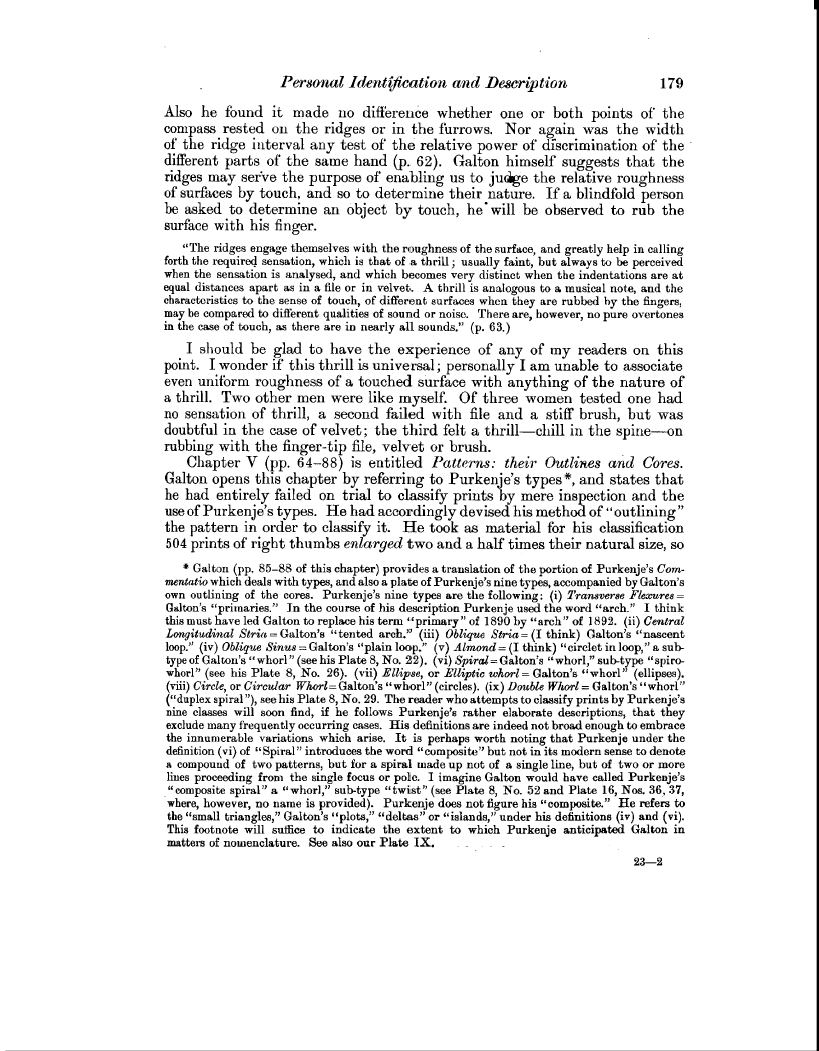| ||||||

OCR Rendition - approximate
Personal Ident%ication and Description 179 Also he fbund it made no difference whether one or both points of the compass rested on the ridges or in the furrows. Nor again was the width of the ridge interval any test of the relative power of discrimination of the different parts of the same hand (p. 62). Galton himself suggests that the ridges may serve the purpose of enabling us to judge the relative roughness of surfaces by touch, and so to determine their nature. If a blindfold person be asked to determine an object by touch, he' will be observed to rub the surface with his finger. "The ridges engage themselves with the roughness of the surface, and greatly help in calling forth the required sensation, which is that of a thrill; usually faint, but always to be perceived when the sensation is analysed, and which becomes very distinct when the indentations are at equal distances apart as in a file or in velvet. A thrill is analogous to a musical note, and the characteristics to the sense of touch, of different surfaces when they are rubbed by the fingers, may be compared to different qualities of sound or noise. There are, however, no pure overtones in the case of touch, as there are in nearly all sounds." (p. 63.) I should be glad to have the experience of any of my readers on this point. I wonder if this thrill is universal; personally I am unable to associate even uniform roughness of a touched surface with anything of the nature of a thrill. Two other men were like myself. Of three women tested one had no sensation of thrill, a second failed with file and a stiff brush, but was doubtful in the case of velvet; the third felt a thrill-chill in the spine-on rubbing with the finger-tip file, velvet or brush. Chapter V (pp. 64-88) is entitled Patterns: their Outlines and Cores. Galton opens this chapter by referring to Purkenje's types*, and states that he had entirely failed on trial to classify prints by mere inspection and the use of Purkenje's types. He had accordingly devised his method of "outlining" the pattern in order to classify it. He took as material for his classification 504 prints of right thumbs enlarged two and a half times their natural size, so * Galton (pp. 85-88 of this chapter) provides a translation of the portion of Purkenje's Commentatio which deals with types, and also a plate of Purkenje's nine types, accompanied by Galton's own outlining of the cores. Purkenje's nine types are the following: (i) Transverse Flexures= Galton's "primaries." In the course of his description Purkenje used the word "arch." I think this must have led Galton to replace his term "primary" of 1890 by "arch" of 1892. (ii) Central Longitudinal Stria = Galton's "tented arch." (iii) Oblique Stria = (I think) Galton's "nascent loop." (iv) Oblique Sinus = Galton's "plain loop." (v) Almond= (I think) "circlet in loop," a subtype of Calton's "whorl" (see his Plate 8, No. 22). (vi) Spiral=Galton's "whorl," sub-type "spirowhorl" (see his Plate 8, No. 26). (vii) Ellipse, or Elliptic whorl =Galton's "whorl" (ellipses). (viii) Circle, or Circular Whorl=Galton's "whorl" (circles). (ix) Double Whorl = Galton's "whorl" ("duplex spiral "), see his Plate 8, No. 29. The reader who attempts to classify prints by Purkenje's nine classes will soon find, if he follows Purkenje's rather elaborate descriptions, that they exclude many frequently occurring cases. His definitions are indeed not broad enough to embrace the innumerable variations which arise. It is perhaps worth noting that Purkenje under the definition (vi) of "Spiral" introduces the word "composite" but not in its modern sense to denote a compound of two patterns, but for a spiral made up not of a single line, but of two or more lines proceeding from the single focus or pole. I imagine Galton would have called Purkenje's "composite spiral" a "whorl," sub-type "twist" (see Plate 8, No. 52 and Plate 16, Nos. 36, 37, where, however, no name is provided). Purkenje does not figure his "composite." He refers to the "small triangles," Galton's "plots," "deltas" or "islands," under his definitions (iv) and (vi). This footnote will suffice to indicate the extent to which Purkenje anticipated Galton in matters of nomenclature. See also our Plate IX. _ 23-2
|